Santa Fe fills niche amid new Hyundai SUV flurry
By John Gilbert
It’s almost as if Hyundai is its own worst enemy. Or maybe we should say Hyundai’s excellence in nearly every segment of the auto business seems to be obscuring some very good Hyundai products in other segments.
A case in point is the Santa Fe. When Hyundai completely redesigned the Santa Fe two years ago, it was truly something special, in my mind. The introduction of the midsize SUV was at Park City, Utah, just east of Salt Lake City, as you head up into the mountains. All of the models we drove were loaded 2019 models, with 2.0-liter turbocharged 4-cylinders.
We drove them to the top of the mountains and then followed some curvy roads at high altitude. As I wrote at the time, my partner was a Hyundai official, so I got to drive the whole way. As I drove quite briskly on those mountain roads, he urged me to go harder, to really see how it performed. I did that, and came away thoroughly impressed.
That was my first experience with Hyundai’s state-of-the-art lane-keeping system. Nearly every company now has something similar, which alerts you if you wander out of your lane, but Hyundai’s was the best I’d tested. What I did was to set the driving mode to the highest sport setting, firming up the steering and suspension, and then I ratcheted up the lane system to go from lane departure alert, past lane-departure assist, all the way to lane-centering assist.
What that does is keeps your Hyundai in the center of the lane, not just in the lane. You could overpower it, but why would you want to? It keeps you in the center of the lane, no matter how aggressively you drive, and it does it better than nearly all other systems I’ve driven.
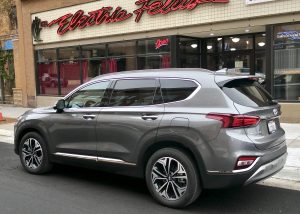
Larger than the Kona and Tucson, smaller than the new Palisade, many might find the Santa Fe just right.
The problem is that Hyundai also came out with a fabulous compact SUV called the Kona, about the same time — a bit smaller, similar in design, and capable of better fuel economy, and also equipped with the lane-centering equipment. Also, Hyundai was about to unveil its all new Palisade — the largest SUV the South Korean conglomerate has ever built. Hyundai’s partner, Kia, has one of its own, called the Telluride, and the differences are so slight I’d challenge anyone to pick their preference. Being a large, three-row SUV that can haul large quantities of people and stuff, it also benefits greatly from the lane-keeping and centering trick.
So rigorous were all those introductions that Hyundai held off on introducing the new Tucson, its stalwart midsize SUV that slots just in between the Kona and the Santa Fe. Indicative of how good those flanking vehicles are, the Kona was named the 2019 car of the year by Newcarpicks.com, and for 2020, the Telluride was named Motor Trend’s SUV of the year.
Obscured by all the adjacent publicity, the Santa Fe got pretty much left out of Hyundai’s advertising campaigns. So it was with great interest that I found myself in line for a week-long test drive at home on Lake Superior’s North Shore during a recent week of this too-soon wintertime — a never-ending flurry of flurries that blanketed us with several of those “once every 20 year” snowstorms.
The Santa Fe was, just as I had recalled, the perfect size to handle any such snowstorms and family hauler requirement.
Also, as impressed as I am with the Kona and its highly efficient size and agility, and with tests of both the large twins Palisade and Telluride, the 2020 Santa Fe plugs right in where it had remained in my memory bank — the perfect size to capitalize on Hyundai’s advanced technology.
The sensory-surprising lane-centering electronics that work so well in everything from the Kona through the Palisade does a great job of making sure you don’t get out of line — literally — in the Santa Fe. You can get the Santa Fe with front-wheel drive only, but why would anyone who lives in or near snow country do that? With the all-wheel drive system, you also have the capability to turn a switch and put the thing in full-time 4-by-4, so that if you were stuck in axle-deep snow, you could shift and get all four wheels pulling equally, very Jeep-line in manners. That same technique works for off-road use, too.
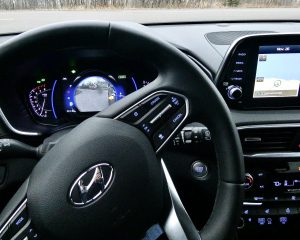
Santa Fe borrows lane-change dash screen from Palisade for 2020, remains best example of unexcelled lane-centering technology.
The Santa Fe also benefits from the fact that Hyundai remains the only auto maker in the world that owns its own steel plant, so it can load up its vehicle with high-grade steel to insure safety as well as chassis rigidity. That also might be the benefit of Santa Fe’s perfect compromise of size, which continues to be in need of being pointed out repeatedly, rather than ignored.
Also, since the bigger Palisade adopted some of Santa Fe’s attributes, it’s only fair that the 2020 Santa Fe gets to use a couple of Palisade features. One, particularly, is something I found very useful on the Palisade. It has to be on the top model, the Ultimate, but it is a nice, large, round speedometer that has a trick inner screen. Let’s say you are driving down the freeway, and you have worked your way out of some congestion but you’re still in the left lane. Time to move to the right, which is only proper, and when you flip the directional stalk just slightly to get the three-flash blinker indicating your intention to change lanes, the inner part of the speedometer becomes a round video screen that shows the image from a tiny camera on the right outside mirror, a panorama of the entire right lane, just so you can be sure you aren’t just ahead of a faster-moving vehicle on your right.
In the bigger, more luxurious Palisade, it was an impressive touch. But now it’s also on the Santa Fe, which is priced from $26,000-$36,000 and punches above its class in every model grade.
The 2.0-liter turbocharged 4-cylinder develops 235 horsepower and 280 foot-pounds of torque. The optional engine in the more base models is the tried and true 2.4-liter 4-cylinder, but is not turbocharged, creating the interesting scenario where the larger 2.4 has 185 horsepower and 176 foot-pounds, meaning the turbo kicks the smaller 2.0 up to higher power grades.
We found we were able to coach 26 miles per gallon out of the 2.0-turbo, if you kept your foot out of it. That is one spot where the lighter, smaller Kona benefits by being powered in a sporty manner by the 1.6-liter turbo, a jewel that also easily gets over 30 miles per gallon.
If fuel economy matters, the Kona is a great alternative. But if you haul adults or large teenagers with any regularity, you will be glad you chose the larger and roomier Santa Fe. Adding the Palisade and the soon-to-come Tucson, Hyundai appears to have a four-pronged edge on all its competition. Just be careful to not overlook whichever one might be the ideal fit for your family.


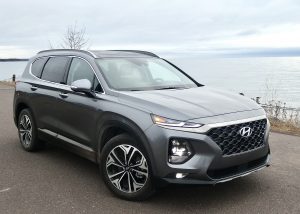
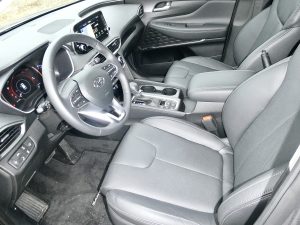
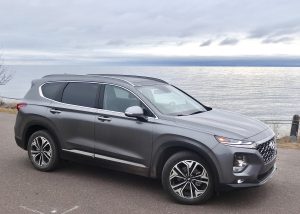
 John Gilbert is a lifetime Minnesotan and career journalist, specializing in cars and sports during and since spending 30 years at the Minneapolis Tribune, now the Star Tribune. More recently, he has continued translating the high-tech world of autos and sharing his passionate insights as a freelance writer/photographer/broadcaster. A member of the prestigious North American Car and Truck of the Year jury since 1993. John can be heard Monday-Friday from 9-11am on 610 KDAL(www.kdal610.com) on the "John Gilbert Show," and writes a column in the Duluth Reader.
John Gilbert is a lifetime Minnesotan and career journalist, specializing in cars and sports during and since spending 30 years at the Minneapolis Tribune, now the Star Tribune. More recently, he has continued translating the high-tech world of autos and sharing his passionate insights as a freelance writer/photographer/broadcaster. A member of the prestigious North American Car and Truck of the Year jury since 1993. John can be heard Monday-Friday from 9-11am on 610 KDAL(www.kdal610.com) on the "John Gilbert Show," and writes a column in the Duluth Reader.